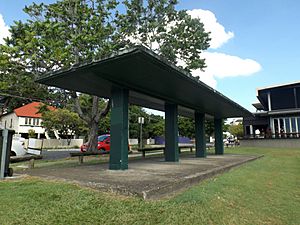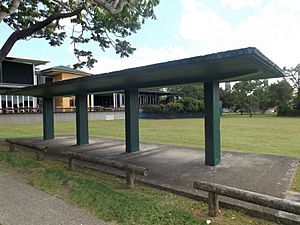Raymond Park (West) Air Raid Shelter facts for kids
Quick facts for kids Raymond Park (West) Air Raid Shelter |
|
|---|---|

Structure in 2015
|
|
| Location | 94 Baines Street, Kangaroo Poinht, Queensland, Australia |
| Design period | 1939 – 1945 (World War II) |
| Built | c. 1942 |
| Architect | Frank Gibson Costello |
| Official name: Raymond Park (West) Air Raid Shelter | |
| Type | state heritage (built) |
| Designated | 6 April 2005 |
| Reference no. | 602478 |
| Significant period | 1942 (fabric) 1940s (historical) |
| Builders | Brisbane City Council |
| Lua error in Module:Location_map at line 420: attempt to index field 'wikibase' (a nil value). | |
The Raymond Park (West) Air Raid Shelter is a special historical building in Raymond Park, Kangaroo Point, Queensland, Australia. It was built around 1942 by the Brisbane City Council to protect people during World War II. The shelter was designed by Frank Gibson Costello. Today, it is recognized as an important part of Queensland's history.
Contents
Why Air Raid Shelters Were Built
World War II Comes to Australia
World War II started in 1939. On December 7, 1941, the United States joined the war. This happened after Japanese planes bombed Pearl Harbor in Hawaii. Soon after, Japanese forces bombed Darwin, Australia, in February 1942. Many Australians were also captured when Singapore fell. These events made Australia realize it needed to prepare for attacks.
Brisbane's Role in the War
Brisbane became a very important city during the war. It was the main city in Queensland and a key military base. Many Australian and American soldiers came to Queensland. They needed new buildings and supplies. General Douglas MacArthur, a top Allied commander, worked from Brisbane. General Sir Thomas Blamey, the Australian commander, also used buildings in Brisbane. Because Brisbane was so important, it was a likely target for bombing. Protecting the people became a top priority.
Building Shelters and Defenses
The Brisbane City Council was in charge of protecting people. They set up air raid wardens and firefighting systems. They also built many air raid shelters. Special saltwater pipes were laid in city streets for firefighters. On Christmas Eve 1941, the government ordered everyone to start building shelters. People dug trenches in parks and schoolyards. Windows were taped to prevent shattering. Lights were dimmed at night to make cities harder to see from the air.
Public Shelters in Brisbane
The government ordered the Brisbane City Council to build 200 public shelters. Work began quickly in December 1941. Eventually, 235 air raid shelters were built. Most were finished by June 1942. The Council also built about three kilometers of covered trenches in parks. These trenches could hold many people. Shelters were also built for important places like wharves and council buildings.
Shelters Across Queensland
Other towns along Queensland's coast also had to build shelters. These shelters had to follow strict rules. They were designed to protect people from bombs. Some towns struggled to build enough shelters. The Department of Public Works helped, but sometimes there were arguments about who should pay. For example, Townsville and Ayr initially refused to pay their share.
Air Raid Shelters Today
Out of the 235 public shelters built in Brisbane, 21 still exist. The Brisbane City Council still owns them. Most of these surviving shelters were designed to be reused after the war.
Clever Designs for the Future
Frank Gibson Costello was the City Architect for Brisbane from 1941 to 1952. He designed the public air raid shelters. Costello wanted the shelters to be useful even after the war. He planned for them to become things like bus stops or park shelters. This way, they wouldn't just be useless concrete blocks. He called this "fitting into schemes of improvement."
Costello's designs were modern for their time. They used simple shapes and strong materials like concrete. Many reusable shelters were built under large fig trees. This helped to hide them from enemy planes.
Different Types of Reusable Shelters
- Park Type Shelters: These shelters had four central pillars. Their outer walls could be removed after the war. This would leave an open space with a roof, perfect for a park shelter. About 17 of these "park" type shelters still exist today. The Raymond Park (West) shelter is one of them.
- Bus Type Shelters: These shelters had three walls that could be removed. They were designed to become bus stops. Only two of these types remain.
- Stone Bus Type Shelters: Similar to the bus type, but with stone walls and pillars. Only one of these survives.
Most of the wartime buildings in Brisbane were removed after World War II. But Costello's reusable shelters, like the one in Raymond Park, survived. Their walls were removed as planned, giving them a new purpose.
What the Shelter Looks Like
The Raymond Park (West) air raid shelter is a rectangular concrete building. It has a thick concrete floor and a flat roof. The roof is held up by strong concrete pillars. Both the pillars and the roof are painted green. You can find the shelter behind the Pineapple Hotel on Baines Street. It's at the western end of Raymond Park. If you look closely at the concrete floor, you might even see some old cat paw prints and shoe prints!
Why This Shelter is Important
The Raymond Park (West) Air Raid Shelter is listed on the Queensland Heritage Register. This means it's a very important historical site.
- Shows Queensland's History: This shelter helps us understand how World War II affected people in Brisbane. It shows how the city prepared to protect its citizens.
- A Rare Survivor: Many air raid shelters were built, but only a few remain. This makes the Raymond Park shelter a rare example of wartime construction by the Brisbane City Council.
- Typical Air Raid Shelter: Its strong build, rectangular shape, and location near people show what a public air raid shelter looked like during World War II.
- Smart Design: The shelter is now used as a park shelter. This shows how clever its original design was. It was built to be useful even after the war ended. It's a great example of how concrete was used during that time.
- Costello's Work: This shelter is an important example of the work done by the City Architect's Office during the war, especially the designs of F.G. Costello.
Images for kids




